The first experience of stapled intestinal anastomoses application in children in Ukraine
DOI:
https://doi.org/10.15574/PS.2020.68.15Keywords:
linear staplers, enteroanastomosis, necrotizing enterocolitis, perforation of the small intestine, newborn premature babyAbstract
Introduction. Conducting reconstructive surgery in children, especially those with low body weight, associated with an increase in the operation time and a worsening of the postoperative period. Therefore, to reduce the operation time, surgical clinics in developed countries of the world use linear staplers for anastomoses in children, especially young children.
Case report. A premature newborn, with a birth weight of 1420 g, was diagnosed with necrotizing enterocolitis, with ileal perforation and diffuse peritonitis. According to vital indications, the operation was performed: laparotomy, revision of the abdominal cavity, Mikulich enterostomy. After complete stabilization of the general condition of the child, upon reaching 2550 g of body weight, at the age of 2 months, enterostomy closure was performed with the imposition of a stapled side-to-side functional end-to-end ileoileostomy. In 14 days after the operation, the child achieved full enteral autonomy. There were no postoperative surgical complications. In the late postoperative period, the child gains weight well, grows and develops according to age.
Conclusion. The use of linear staplers in time of enteroanastomoses creation can significantly reduce operation time in children, in particular, premature babies with low body weight.
Level of evidence. Level V.
The research was carried out in accordance with the principles of the Helsinki Declaration. The study protocol was approved by the Local Ethics Committee of an participating institution.The informed consent of the child’s parents was obtained from the studies.
References
Blakely ML, Lally KP, Mc Donald S et al. (2005). NEC Subcommittee of the NICHD Neonatal Research Network. Postoperative outcomes of extremely low birth-weight infants with necrotizing enterocolitis or isolated intestinal perforation: a prospective cohort study by the NICHD Neonatal Research Network. AnnSurg. 241: 984–989.
Blakely ML, Tyson JE, Lally KP et al. (2006). NICHD Neonatal Research Network. Laparotomy versus peritoneal drainage for necrotizing enterocolitis or isolated intestinal perforation in extremely low birth weight infants: outcomes through 18 months adjusted age. Pediatrics. 117: e680-687. https://doi.org/10.1542/peds.2005-1273; PMid:16549503
Broekaert I, Keller T, Schulten D et al. (2018). Peritoneal drainage in pneumoperitoneum in extremely low birth weight infants. Eur J Pediatr.177: 853-858. https://doi.org/10.1007/s00431-018-3131-0; PMid:29582144
Choy PY, Bissett IP, Docherty JG et al. (2007). Stapled versus handsewn methods for ileocolic anastomoses. Cochrane Database Syst Rev. 18: CD004320. https://doi.org/10.1002/14651858.CD004320.pub2
Colin Muncie, Michael Morris, Barry Berch et al. (2018). Stapled intestinal anastomoses with endoscopic staplers in premature infants. Journal of Pediatric Surgery. 53: 126-129. https://doi.org/10.1016/j.jpedsurg.2017.10.024; PMid:29113677
Golda T, Zerpa C, Kreisler E et al. (2013). Incidence and management of anastomotic bleeding after ileocolic anastomosis. Colorectal Dis. 15: 1301-1308. https://doi.org/10.1111/codi.12309; PMid:23710632
Goulder Frances. (2012). Bowel anastomoses: Thetheory, the practice and the evidence base. World J Gastrointest Surg. 4: 208-213. https://doi.org/10.4240/wjgs.v4.i9.208; PMid:23293735 PMCid:PMC3536859
Graeme C. Hintz, Abdullah Alshehri, Carolyn M. Bell, Sonia A. Butterworth. (2018). Stapled versus hand-sewn pediatric intestinal anastomoses: A retrospective cohort study. Journal of Pediatric Surgery. 53: 959-963. https://doi.org/10.1016/j.jpedsurg.2018.02.021; PMid:29559177
Hizuru Amano, Yujiro Tanaka, Takahisa Tainaka. (2018). The impact of body weight on stapled anastomosis in pediatric patients. Journal of Pediatric Surgery. 53: 2036-2040. https://doi.org/10.1016/j.jpedsurg.2018.04.030; PMid:29792281
Ian C.S. Mitchell, Robert Barber, Anne C. Fischer et al. (2011). Experience performing 64 consecutive stapled intestinal anastomoses in small children and infants. Journal of Pediatric Surgery. 46: 128-130. https://doi.org/10.1016/j.jpedsurg.2010.09.076; PMid:21238653
Jackson CC, Bettolli MM, De Carli CF et al. (2007). Beware of stapled side-to side anastomoses in small children. Eur J Pediatr Surg. 17: 426-427. https://doi.org/10.1055/s-2007-989268; PMid:18072030
Lindsay Wrighton, Jennifer L. Curtis, Gerald Gollin. (2008). Stapled intestinal anastomoses in infants. Journal of Pediatric Surgery. 43: 2231-2234. https://doi.org/10.1016/j.jpedsurg.2008.08.052; PMid:19040941
Randall W. Powell. (1995, February). Stapled Intestinal Anastomosis in Neonates and Infants: Use of the Endoscopic Intestinal Stapler. Journal of Pediatric Surgery. 30(2): 195-197. https://doi.org/10.1016/0022-3468(95)90559-6
Sato K, Uchida H, Tanaka Y et al. (2012). Stapled intestinal anastomosis is a simple and reliable method for management of intestinal caliber discrepancy in children. Pediatr Surg Int. 28: 893-898. https://doi.org/10.1007/s00383-012-3146-y; PMid:22864546 PMCid:PMC3433672
Sliepov O, Migur M, Ponomarenko O. (2020). Organ-preserving principles of reconstructive surgery for type IV intestinal atresia in newborns. Paediatric surgery. Ukraine. 1(66): 21-26. https://doi.org/10.15574/PS.2020.66.21
Sliepov O, Wales P, Migur M, Ponomarenko O. (2019). The first experience in stapled longitudinal tapering enteroplasty in three month old child with ileal atresia in Ukraine. Paediatric surgery. Ukraine. 1(62): 18-24. https://doi.org/10.15574/PS.2019.62.18
Stoll BJ, Hansen NI, Bell EF et al. (2016). Practices, morbidity, and mortality of extremely preterm neonates, 1993-2012. Obstet Gynecol Surv. 71: 7-9. https://doi.org/10.1097/01.aoa.0000482610.95044.1b
Wrighton L, Curtis JL, Gollin G. (2008). Stapled intestinal anastomoses in infants. J Pediatr Surg. 43: 2231-2234. https://doi.org/10.1016/j.jpedsurg.2008.08.052; PMid:19040941
Downloads
Published
Issue
Section
License
The policy of the Journal “PAEDIATRIC SURGERY. UKRAINE” is compatible with the vast majority of funders' of open access and self-archiving policies. The journal provides immediate open access route being convinced that everyone – not only scientists - can benefit from research results, and publishes articles exclusively under open access distribution, with a Creative Commons Attribution-Noncommercial 4.0 international license(СС BY-NC).
Authors transfer the copyright to the Journal “PAEDIATRIC SURGERY.UKRAINE” when the manuscript is accepted for publication. Authors declare that this manuscript has not been published nor is under simultaneous consideration for publication elsewhere. After publication, the articles become freely available on-line to the public.
Readers have the right to use, distribute, and reproduce articles in any medium, provided the articles and the journal are properly cited.
The use of published materials for commercial purposes is strongly prohibited.

